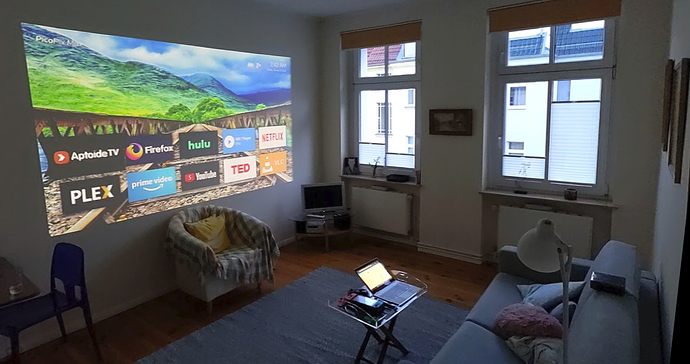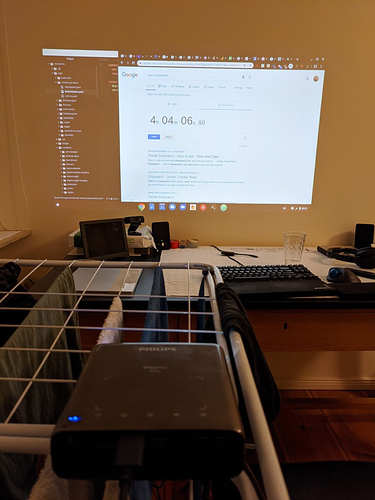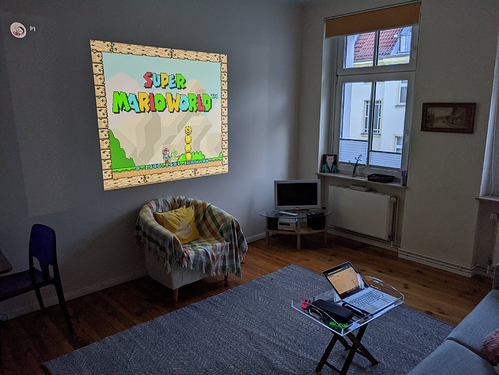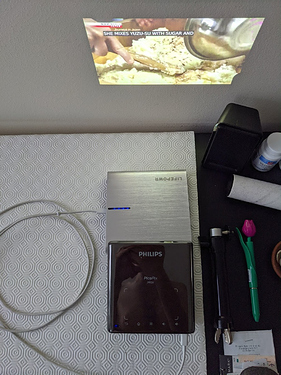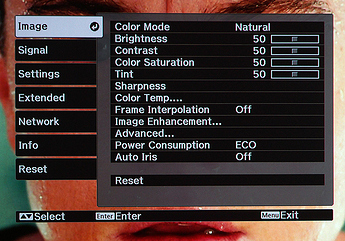Hello all! Long post warning. I received my PicoPix Max 10 days ago and figure it’s time to write up my thoughts in one place  I’ll start with some background before getting into it and attaching some photos. I’ve used only Software Version 1.0.25. Feel free to reply with questions, though I already spent a lot of time on this forum and might not have much more to add.
I’ll start with some background before getting into it and attaching some photos. I’ve used only Software Version 1.0.25. Feel free to reply with questions, though I already spent a lot of time on this forum and might not have much more to add.
my quick background
I’ve yet to own a TV, have vastly preferred projection since I got my first 720p ‘Epson Home Cinema’ 10 years ago. I just recently sold both my Epsons to move abroad, and super conveniently my PicoPix Max arrived mere hours before I left for the airport! My media lifestyle in Berlin is basically being defined by the PPM thanks to its portability.
my quick takes
The single best aspect of the Max is the fact that it throws video like a moderately priced home theater projector while being as portable as an Android tablet. I’ve been using almost entirely Energy Saver brightness mode and haven’t had problems at that level. if you never plan on moving PicoPix Max outside of your Home Theater, maybe you’d be better off with a classic wall powered projector.
Realistically, I haven’t noticed any raw projection issues that weren’t something the Epson projectors also had. For example, a dark gray outline shape when viewed in a dark room. Welcome to consumer projectors. If you want great contrast, get an OLED TV. 
The single worst aspect is the current state of the software. Holy crap, I could just enumerate crappy points of the OS. A couple:
- Please give us battery percentage!!
- did you notice it always boots in 2016, then tries switching to Internet real time? why??
- The system menus are too complex. For example, changing to “Ceiling Front” projection from a fresh boot takes: Up, Ok, Ok, Down, Right, Ok, Down, Down, Ok, Down, Down, Ok, Back, Back, Back. 15 Button Presses to change mount location on a portable projector. Changing input requires similar, which hurts because leaving an input is the best way to autofocus, and you need to dig in to go back to where you were. We need a faster access to common options.
- Something’s funky about the configured display density in Android. Third party apps display text and such much too small. This should be enlarged, but also ideally configurable

Supposedly the software is nowhere near finished, so hopefully I can come back and edit the list over time.
We didn’t get Android TV. We aren’t on the latest Android. It doesn’t seem we’ll ever get Android TV or a newer Android. And we don’t have Google certification.
 This is not latest Android on peak performance, this is general purpose Android being modified to support the exact needs of the product.
This is not latest Android on peak performance, this is general purpose Android being modified to support the exact needs of the product.
positive ranting & raving
- Autofocus is a neat trick. I appreciate being able to press ‘focus’ on a remote instead of getting up and adjusting the focus ring while squinting at the wall. It’s not 100% reliable but easy enough to rerun.
- Battery life has been excellent. In testing, Energy Saver with HDMI input, I reached 4h 40m. Realistically I frequently run with power connected and also charge Max overnight, so I haven’t had it die on me yet.
- USB-C Charging means big flexibility in powering Max. I have multiple chargers to top up the battery, and I can also efficiently power Max away from a wall socket using USB-C batteries. This is most useful when you consider that Max becomes notably brighter without increasing fan noise when you apply input power.
- Bluetooth Audio outperformed all my expectations. I forgot that Android adjusts video playback for latency. I paired Max to a 5-year-old Bluetooth speaker and holy crap, 100% cable-free playback with good video and solid sound. Wow.
- Headphone Jack is still welcomed. My previous Epson projectors never included audio out, so it was up to me to get the audio some other way. Now I can cable the audio easily enough.
- The built-in speaker is surprisingly usable. Obviously not great for movie dialogue, but when playing Switch games I’ve been most satisfied just using onboard sound at about 35% volume. (This is important since Max won’t send external input audio to Bluetooth
 )
) - Quick power-on, no need for warm-up, ready to go after the boot screen. Shuts down quickly too. Not quite instant but it’s fast.
- The wireless network connection has been on great behavior. No buffering, random disconnections, or weak signal problems. This is using the ISP’s wireless modem/router combo.
- USB-C Input has proven to be quite flexible. For example, Nintendo Switch will natively ‘dock’ to PicoPix Max. More on that later.
- Three different lamp brightness options. I’m used to 2 (Normal, Eco) and 3 is nice flexibility even though fan noise becomes real on Presentation.
- Gaming-acceptable latency on the video inputs (I’m told 36ms) is always good to have. Haven’t felt any lag playing Smash Bros or Super Hexagon.
some papercuts & glitches
The UI isn’t the only negative, so I’ll try ignoring the current terrible UI for a minute.
- The tripod mount is pretty wonky. The screw receiver sticks out instead of being sunk in, so it’s pretty shallow and doesn’t make proper contact. Noted previously: Design issues with tripod mount, and other minor issues
- I’d love to see more buttons on the projector. Ignoring the touchpad, I should be able to quickly pull up Picture settings to adjust the projection options directly from the unit. And ideally with physical buttons though I suppose that’s a design choice.
- Sometimes, the picture starts briefly freezing, showing pixelation for a handful of frames. I’m not entirely sure what causes this. Screeneo has claimed it’s from autokeystone. This hasn’t happened enough to be a problem yet.
- Less frequently, and I think particularly at higher brightness, the picture momentarily blanks and comes back at a slightly different color, then momentarily blanks again and comes back normally. I’ve been meaning to get this on camera but it’s even more rare.
- Sometimes bluetooth doesn’t fully set up automatically and I have to manually connect the speaker. If I turn on the projector before my bluetooth speaker this is more likely.
- Why is Autofocus sharing space with the volume rocker on the remote? Seems like that’s where the mute button should be instead. I don’t want to accidentally refocus when turning up a good part.
- A couple times, the volume adjusted on its own?? ghost touches on the touchpad maybe?
- A companion mobile remote app would be nice. In particular, to type into textboxes and switch apps. I hope we’ll see something eventually.
- It’s pretty dumb that the included tripod cannot properly point PicoPix Max at a ceiling. I’ve substituted my own tabletop tripod in this review.
practical usecases so far
Ok, this is my favorite part. As mentioned, PicoPix Max is the only projector I have right now, and effectively the only screen above 20" in my flat. So I’ve taken the flexibility to heart.
Locations:
Primarily the living room, of course! I can get a nice big picture putting Max behind the couch, shown below. Other times I put it on the coffee table for a smaller, brighter, more stable picture. Depends on the context.
When it’s time for some late night Smash, I toss Max onto my old tripod, set Ceiling projection and point it up 90° from the bedside table. For gaming at this distance I also often attach a charger to get the extra brightness. Photo of my third party tripod pointed up:
Another recurring location is at my desk, as I have yet to purchase a proper computer monitor. Here the largest annoyance is getting everything into focus. It’s easy to focus the center, but text in corners is often still blurry. Also just in general it’s awkward to position a projector at a desk haha! Photo from when I was testing HDMI battery life.
I’m still experimenting with more locations. For example, using my kitchen wall to catch up on news while eating breakfast. I think the next big step is taking Max on the go, where wall power is actually not available. This would’ve happened already if I wasn’t newly in a foreign country haha
Content:
I’ve been living mostly within two Android apps. Both of these apps always play smoothly without buffering. I hear bad things about the other DRM-heavy apps, so your mileage may vary. My biggest problem is the display density - all the UI is too small! 

- S YouTube gives me Internet videos. I immediately logged in with Youtube Premium easily enough. Finding specific videos with the remote is a pain, so I found it easiest to pair our phones via “TV Code” so me and the gf can take turns queueing videos from proper touchscreens.
-
Plex gives me TV and movies. I have access to a decked out Plex server so this works well for me. I installed the mobile app from Aptoide and activated the TV UI.
One particularly cool aspect here is my Plex server has access to an HDHomeRun TV tuner. So I can also stream actual American TV from a live guide:
Outside of Android video: Gaming! See Nintendo Switch without a dock :)
This was perfect since I left my Switch Dock in the US. I was totally expecting to be unable to dock it for ages.
(Sadly, the battery situation isn’t great doing this - Max charges Switch at only 7.5 watts, so Max dies sooner from sharing battery power, but Switch also doesn’t get enough power to sustain itself and will eventually die without the proper dock. You can feed Max power to keep it going, but once Switch dies you need to take a break to charge it up.)
Accessories:
The most important accessory for TV watching is a speaker. I’ve been using a Sony SRS-X77, released in 2015 and with battery life on-par with Max. Works a treat over Bluetooth. If I’m watching videos, I’m using this speaker.
Another important accessory is power adapters. Again, you get extra brightness without increased fan noise by supplying USB-C power. Some people have found chargers that Max won’t accept, I’ve been more fortunate  As far as batteries I’m using a LifePowr A3, also from Indiegogo, which is actually the same size as Max. I estimate it can adds up to 6 hours to Max.
As far as batteries I’m using a LifePowr A3, also from Indiegogo, which is actually the same size as Max. I estimate it can adds up to 6 hours to Max.
in conclusion
Look, this project is ultimately an overgrown pico projector.
They took a niche projector market that has always been dim and clunky, and scaled it back up towards normal consumer projectors. I really respect the fact that I can take this thing wherever. It’s a lot of flexibility and I love my projector even with the current crappy software. You can have just the projector and be watching Youtube. You can add better sound a couple ways, you can add a tripod to point it more freely. You can plug in a game console. You decide.
Once the software is more ready I will be recommending these to people who want to try out the projector lifestyle.
However, there are compromises - fundamental lack of a proper On-Screen Display, and heavy bias towards Android content, to name a couple. Ultimately, if you want a full featured home cinema, there are better options that do not include a battery.

